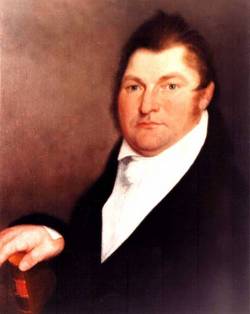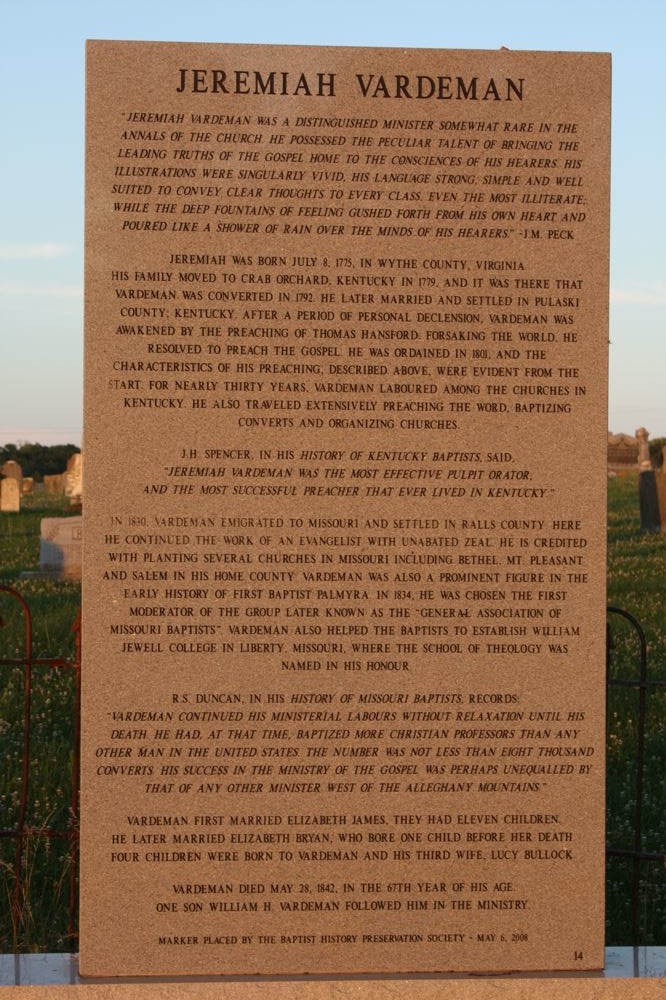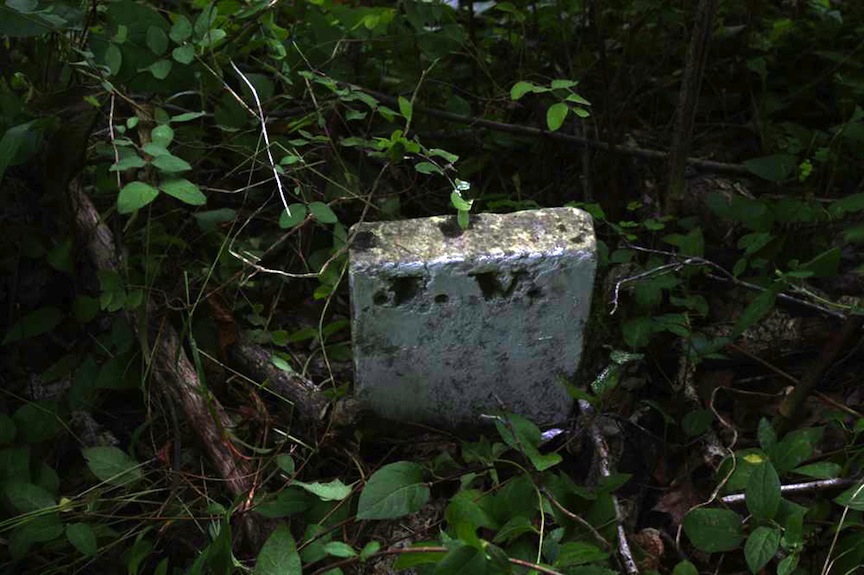Jeremiah Vardeman: From the Dance Hall to the Pulpit
In 1796, eleven year old John Smith was sent by his father from Wayne County's Stockton's Valley to Crab Orchard for the purpose of securing corn for food and for planting. Crab Orchard, Kentucky, located on the Wilderness Road, was approximately one hundred miles from young Smith's wilderness cabin. There he gazed for the first time upon the personage of three hundred pound Jeremiah Vardeman who was playing the fiddle for a dance. Destiny would have the courses of the two crossing many times in subsequent years.
"At the time Smith first saw Vardeman, the latter had been in the area for at least five or six years. In 1792 he had been baptized into the Cedar Creek Baptist Church at Crab Orchard. However, the fiddle and the dance soon resulted in his being dismissed from the church." {J.H. Spencer, A History of Kentucky Baptists, 2 Vols. (Printed for the author. 1886; reprint ed. Lafayette. Tennessee; Church History Research and Archive, 1976) Vol. 1. p.234} Vardeman was soon reclaimed by the preaching of the "unlettered" Thomas Hansford and quickly became the best-known Baptist preacher in Kentucky during the first quarter of the nineteenth century. He is best remembered for his "prodigious and unusually effective evangelistic preaching," rather than for work in a particular locality. Beyond his being very talented, he was gifted with a sonorous voice which permitted an "acre of people" to hear him clearly. --S. J. Conkwright History of Churches of Boone’s Creek Baptist Association, Winchester, Kentucky, 1923, p. 71.
At the annual meeting of the Cumberland Baptist Association in 1810, fourteen years after his first glimpse of the impressive fiddler, John Smith became formally acquainted with Vardeman. By this time Smith was twenty-six years old and had begun preaching at Pannleysville for the Bethel Baptist Church, which was located in the Horse Hollow section of Wayne County, Kentucky. Vardeman had heard of the talented country preacher and was looking forward to meeting him. Many years later, when reflecting upon this occasion, Smith remembered that the famous preacher "took me to himself as a brother." --John Augustus Williams, Life of Elder John Smith, Cincinnati, R.W. Carroll and Co., 1870, p. 96.
The center of Vardeman's activities shifted to Central Kentucky during the year 1810. Even though his efforts focused primarily at David's Fork and Bryan's Station in Fayette County, he attended monthly the Grassy Lick and Lulbegrud churches in Montgomery County. Eventually he came to believe that Montgomery County was the area where the temperament and talents of John Smith could most successfully be applied.
In 1817, Smith yielded to the persistence of Vardeman to come to the care of the "destitute" churches of Montgomery. {Smith, p. 134.} This move to the Bluegrass Region. In effect, brought Smith into contact with a movement which consumed the country preacher from Horse Hollow. He spent the remainder of his life in Central Kentucky, and eventually, one-half century later, his mortal remains were deposited in her soil.
The popular Vardeman was requested, in the fall of 1823 to serve as moderator lor Alexander Campbell in the latter's debate with W. L. McCalla in the small town of Washington, Kentucky. Soon after the Campbell-McCalla debate, Vardeman accepted Campbell's position on baptism and declared it effectively for approximately five years.
Especially noteworthy was a meeting in Cincinnati in 1828. Alexander Campbell reported that in the September issue of the Christian Baptist that a correspondent informs that Bishop Jeremiah Vardeman arrived in Cincinnati the Friday before the 4th day in June, and immediately after his arrival he immersed 33, and had it not been for ill health, 10 more would have been immersed the same day. Thus in three weeks 118 persons were immersed in the belief of the gospel through the instrumentality of one individual proclaiming reformation towards God and faith in the Lord Jesus Christ. --Alexander Campbell, "Religious News," Christian Baptist Vol. VI, No.2 , Sept. 1828, p. 47.
In 1829, John Smith made an urgent visit to David's Fork in Fayette County where Vardeman was preaching. He had heard that his old friend had abruptly departed the Reformers and rejoined the Baptists. The visit was a most unpleasant one because his greatest fear was confirmed. --John Augustus Williams. Life of Elder John Smith (Cincinnati. R. W. Carroll and Co., 1870, pp. 312-13.
Soon after his rejoining the Baptists, Vardeman moved from Kentucky to Missouri and for twelve years worked rather diligently at promoting the Baptist cause in that state. He died in 1842 and was buried in a family grave plot on his farm. Unfortunately, his "sepulchre lieth waste." The stone of the famous preacher of yesteryear is broken approximately one foot above ground level and the portion containing the inscription is in fragments. --Everett Donaldson. “Jeremiah Vardeman – His Sepulchre Lieth Waste,” The World Evangelist , June 1990, p. 5; Everett Donaldson, 1991 Freed-Hardeman University Lectureship, Except, pp. 103-105.
Jeremiah Vardeman: From the Dance Hall to the Pulpit
In 1796, eleven year old John Smith was sent by his father from Wayne County's Stockton's Valley to Crab Orchard for the purpose of securing corn for food and for planting. Crab Orchard, Kentucky, located on the Wilderness Road, was approximately one hundred miles from young Smith's wilderness cabin. There he gazed for the first time upon the personage of three hundred pound Jeremiah Vardeman who was playing the fiddle for a dance. Destiny would have the courses of the two crossing many times in subsequent years.
"At the time Smith first saw Vardeman, the latter had been in the area for at least five or six years. In 1792 he had been baptized into the Cedar Creek Baptist Church at Crab Orchard. However, the fiddle and the dance soon resulted in his being dismissed from the church." {J.H. Spencer, A History of Kentucky Baptists, 2 Vols. (Printed for the author. 1886; reprint ed. Lafayette. Tennessee; Church History Research and Archive, 1976) Vol. 1. p.234} Vardeman was soon reclaimed by the preaching of the "unlettered" Thomas Hansford and quickly became the best-known Baptist preacher in Kentucky during the first quarter of the nineteenth century. He is best remembered for his "prodigious and unusually effective evangelistic preaching," rather than for work in a particular locality. Beyond his being very talented, he was gifted with a sonorous voice which permitted an "acre of people" to hear him clearly. --S. J. Conkwright History of Churches of Boone’s Creek Baptist Association, Winchester, Kentucky, 1923, p. 71.
At the annual meeting of the Cumberland Baptist Association in 1810, fourteen years after his first glimpse of the impressive fiddler, John Smith became formally acquainted with Vardeman. By this time Smith was twenty-six years old and had begun preaching at Pannleysville for the Bethel Baptist Church, which was located in the Horse Hollow section of Wayne County, Kentucky. Vardeman had heard of the talented country preacher and was looking forward to meeting him. Many years later, when reflecting upon this occasion, Smith remembered that the famous preacher "took me to himself as a brother." --John Augustus Williams, Life of Elder John Smith, Cincinnati, R.W. Carroll and Co., 1870, p. 96.
The center of Vardeman's activities shifted to Central Kentucky during the year 1810. Even though his efforts focused primarily at David's Fork and Bryan's Station in Fayette County, he attended monthly the Grassy Lick and Lulbegrud churches in Montgomery County. Eventually he came to believe that Montgomery County was the area where the temperament and talents of John Smith could most successfully be applied.
In 1817, Smith yielded to the persistence of Vardeman to come to the care of the "destitute" churches of Montgomery. {Smith, p. 134.} This move to the Bluegrass Region. In effect, brought Smith into contact with a movement which consumed the country preacher from Horse Hollow. He spent the remainder of his life in Central Kentucky, and eventually, one-half century later, his mortal remains were deposited in her soil.
The popular Vardeman was requested, in the fall of 1823 to serve as moderator lor Alexander Campbell in the latter's debate with W. L. McCalla in the small town of Washington, Kentucky. Soon after the Campbell-McCalla debate, Vardeman accepted Campbell's position on baptism and declared it effectively for approximately five years.
Especially noteworthy was a meeting in Cincinnati in 1828. Alexander Campbell reported that in the September issue of the Christian Baptist that a correspondent informs that Bishop Jeremiah Vardeman arrived in Cincinnati the Friday before the 4th day in June, and immediately after his arrival he immersed 33, and had it not been for ill health, 10 more would have been immersed the same day. Thus in three weeks 118 persons were immersed in the belief of the gospel through the instrumentality of one individual proclaiming reformation towards God and faith in the Lord Jesus Christ. --Alexander Campbell, "Religious News," Christian Baptist Vol. VI, No.2 , Sept. 1828, p. 47.
In 1829, John Smith made an urgent visit to David's Fork in Fayette County where Vardeman was preaching. He had heard that his old friend had abruptly departed the Reformers and rejoined the Baptists. The visit was a most unpleasant one because his greatest fear was confirmed. --John Augustus Williams. Life of Elder John Smith (Cincinnati. R. W. Carroll and Co., 1870, pp. 312-13.
Soon after his rejoining the Baptists, Vardeman moved from Kentucky to Missouri and for twelve years worked rather diligently at promoting the Baptist cause in that state. He died in 1842 and was buried in a family grave plot on his farm. Unfortunately, his "sepulchre lieth waste." The stone of the famous preacher of yesteryear is broken approximately one foot above ground level and the portion containing the inscription is in fragments. --Everett Donaldson. “Jeremiah Vardeman – His Sepulchre Lieth Waste,” The World Evangelist , June 1990, p. 5; Everett Donaldson, 1991 Freed-Hardeman University Lectureship, Except, pp. 103-105.
Gravesite Details
In the summer of 2009, this tombstone was dug out of the ground and pieced together by Tom Childers, Wayne Kilpatrick, and Scott Harp.


















